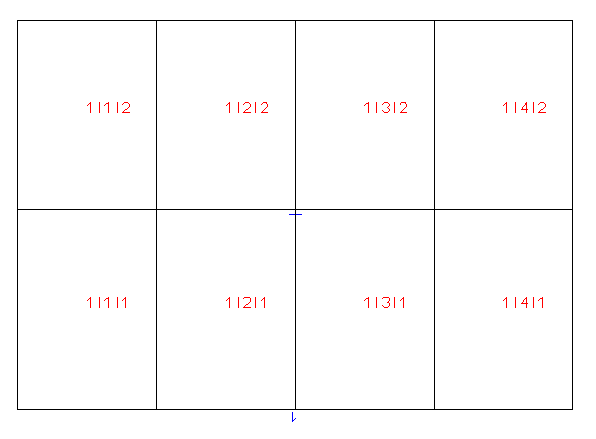Each geometric element of a facade (point/line/area) has an address that is the result of the subdivision.
An address consists of several numbers separated by spaces.
Example of an address for a surface that is not subdivided:

After a horizontal division, the address looks like this:

Then the surface is subdivided vertically. The result looks like this:

The number of the grid line used for subdividing a field is appended to the address of this field:
You can use wildcard (*) and joker characters (?):
Address joker
* addresses all the fields in the above facade.
Address wildcards
1 1 ? addresses the two fields on the left (1 1 1 / 1 1 2).
? ? 1 addresses all the fields in the line at the bottom.
Address ranges
You can also specify a range:
1 2-4 1 addresses the fields: 1 2 1 / 1 3 1 /1 4 1
Inverting address
A number or range preceded by an exclamation mark (!) means that all the numbers except the one marked are addressed. An example:
1 !2 1 addresses the fields: 1 1 1 / 1 3 1 / 1 4 1
1 !2-3 1 addresses the fields: 1 1 1 / 1 4 1
Address modulo
You can use the modulo operator (%) to address very second field, for example:
1 2%0 ? addresses the fields: 1 2 1 / 1 2 2 /1 4 1 / 1 4 2
Address random number
Entering the $ character instead of the modulo character addresses a random field:
3$0 means: random distribution of all 3 fields; addresses the first field.
3$1 means: random distribution of all 3 fields; addresses the second field.
3$3 means: random distribution of all 3 fields; addresses the third field.
When you enter these three addresses in the Object design dialog box, for example, ...
3$0 red panel
3$1 blue panel
3$2 green panel
... each panel occurs exactly once in a block of three fields. The sequence is also the same. The blocks only differ in the panel (red, green or blue) with which the process starts.
| (C) Allplan GmbH | Privacy policy |